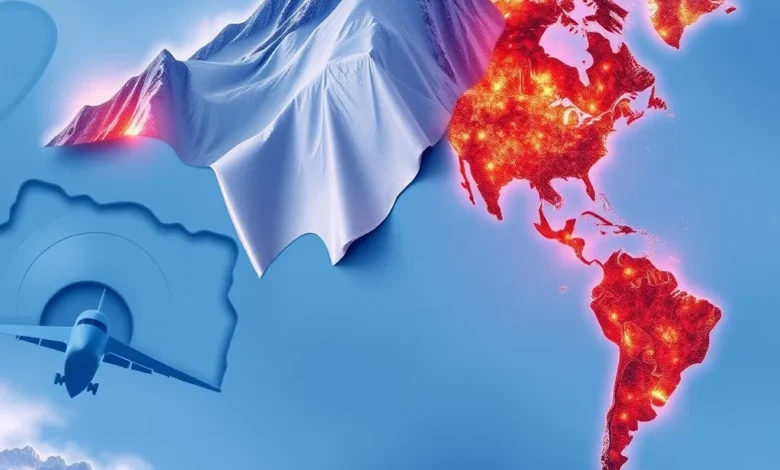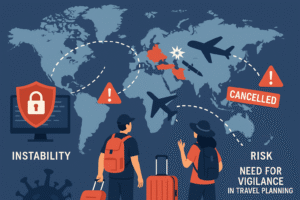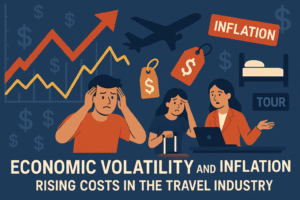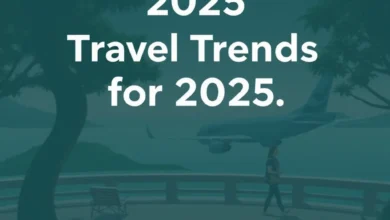What to Watch in 2025: Global Risks and Opportunities in the Travel Industry

The travel industry in 2025 stands at a crossroads, shaped by a complex mix of global risks and emerging opportunities. While the sector is showing impressive resilience and a steady recovery from the pandemic, it must now navigate a landscape marked by geopolitical tensions, economic volatility, climate change, labor shortages, and rapidly evolving traveler expectations. Here’s an in-depth look at the key risks and opportunities that will define travel in 2025—and what travelers, businesses, and destinations should watch most closely.
Geopolitical Tensions and Security Risks
One of the most significant challenges for the industry this year is the rise in geopolitical instability. Ongoing conflicts in regions such as Eastern Europe and the Middle East, as well as strained relations between global powers, are reshaping travel routes and destination choices. The absence of a dominant power group to uphold world order has created power vacuums, emboldening rogue actors and increasing the risk of conflicts, cyberattacks, and sudden disruptions.
For travelers, this means a greater need to stay informed about security risks, potential travel advisories, and the possibility of flight route changes or cancellations. For the industry, increased insurance costs, stricter regulations, and the need for robust crisis management protocols are now the norm. Destinations near conflict zones may see declines in arrivals, while neighboring countries could experience a surge as travelers seek safer alternatives.
Economic Volatility and Inflation
Rising costs of living and inflation are directly impacting both travelers and travel businesses. For tourists, higher prices for flights, accommodations, and experiences can limit travel frequency and destination choices. For the industry, increased labor and operational costs pose challenges to profitability, especially as businesses strive to balance affordability with quality.
Economic uncertainty also affects consumer confidence and travel budgets. While some markets, like India, are seeing a surge in travel spending, others remain cautious. The industry’s ability to offer flexible pricing, value-driven packages, and creative promotions will be key to attracting both budget-conscious and premium travelers.
Labor Shortages and Service Quality
Staffing shortages remain a persistent issue in hospitality, aviation, and related sectors. The competition for skilled workers is fierce, and businesses are under pressure to offer better wages, benefits, and working conditions. These challenges can affect service quality, operational efficiency, and the overall traveler experience. Companies that invest in employee well-being and training, as well as technology to streamline operations, will be better positioned to thrive.
Climate Change and Sustainability
Climate change is a defining force in travel for 2025. Extreme weather events, heatwaves, floods, and wildfires are not only influencing destination choices but also prompting travelers to seek cooler or safer locations—a trend known as “coolcationing.” There’s also a rise in “last-chance tourism,” with travelers eager to visit places threatened by climate change before they’re irrevocably altered.
Sustainability is no longer optional. Travelers are increasingly seeking eco-friendly accommodations, low-emission transportation, and experiences that benefit local communities. Destinations and companies that prioritize environmental responsibility—through green certifications, carbon-neutral initiatives, and support for conservation—are gaining favor with a new generation of conscious travelers.
Technology and Digital Transformation
Technology is both a challenge and an opportunity in 2025. The rise of artificial intelligence, automation, and digital platforms is transforming every aspect of the travel experience—from personalized recommendations and seamless booking to real-time safety alerts and immersive virtual previews of destinations. However, increased reliance on technology also brings cybersecurity risks and the need for robust data protection.
Travelers expect hyper-personalized journeys, mobile-first solutions, and instant access to information. Businesses that leverage AI for customer service, itinerary planning, and operational efficiency will stand out, while those that fail to adapt may fall behind.
Changing Traveler Preferences
The traveler of 2025 is more discerning, flexible, and values-driven than ever before. There’s a growing demand for authentic local experiences, longer stays, and slow travel. Solo adventures, wellness retreats, and multi-generational trips are on the rise. At the same time, travelers are seeking greater flexibility—both in booking and in-destination experiences—to accommodate changing plans and unforeseen disruptions.
demand for authentic local experiences, longer stays, and slow travel. Solo adventures, wellness retreats, and multi-generational trips are on the rise. At the same time, travelers are seeking greater flexibility—both in booking and in-destination experiences—to accommodate changing plans and unforeseen disruptions.
Opportunities on the Horizon
Despite the risks, 2025 presents significant opportunities for those willing to innovate and adapt. The industry is expected to see a 9% increase in global travel spending, with strong growth in emerging markets and among younger travelers. Sustainable tourism, tech-driven personalization, and immersive experiences are opening new revenue streams and business models.
Destinations that invest in resilience, sustainability, and digital infrastructure will be best positioned to attract visitors. Businesses that prioritize traveler safety, flexibility, and authentic engagement will build loyalty and thrive in a competitive landscape.
Conclusion
In 2025, the travel industry is defined by both uncertainty and potential. Navigating geopolitical risks, economic pressures, and environmental challenges requires agility, innovation, and a deep understanding of traveler needs. By embracing sustainability, investing in technology, and putting people at the center of every journey, the industry can turn today’s risks into tomorrow’s opportunities—ensuring that travel remains a powerful force for connection, discovery, and positive change.




